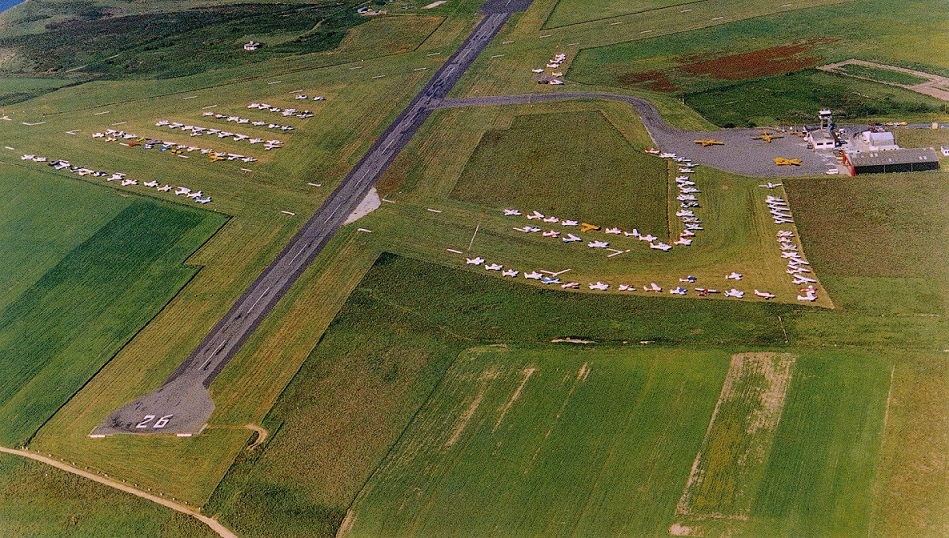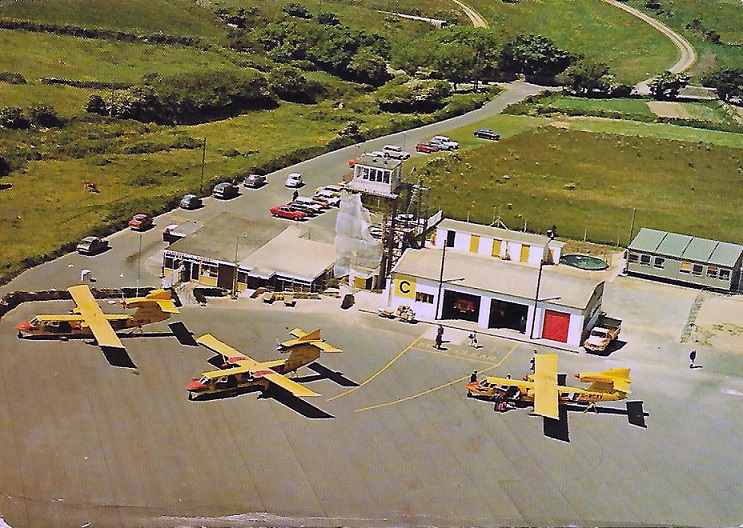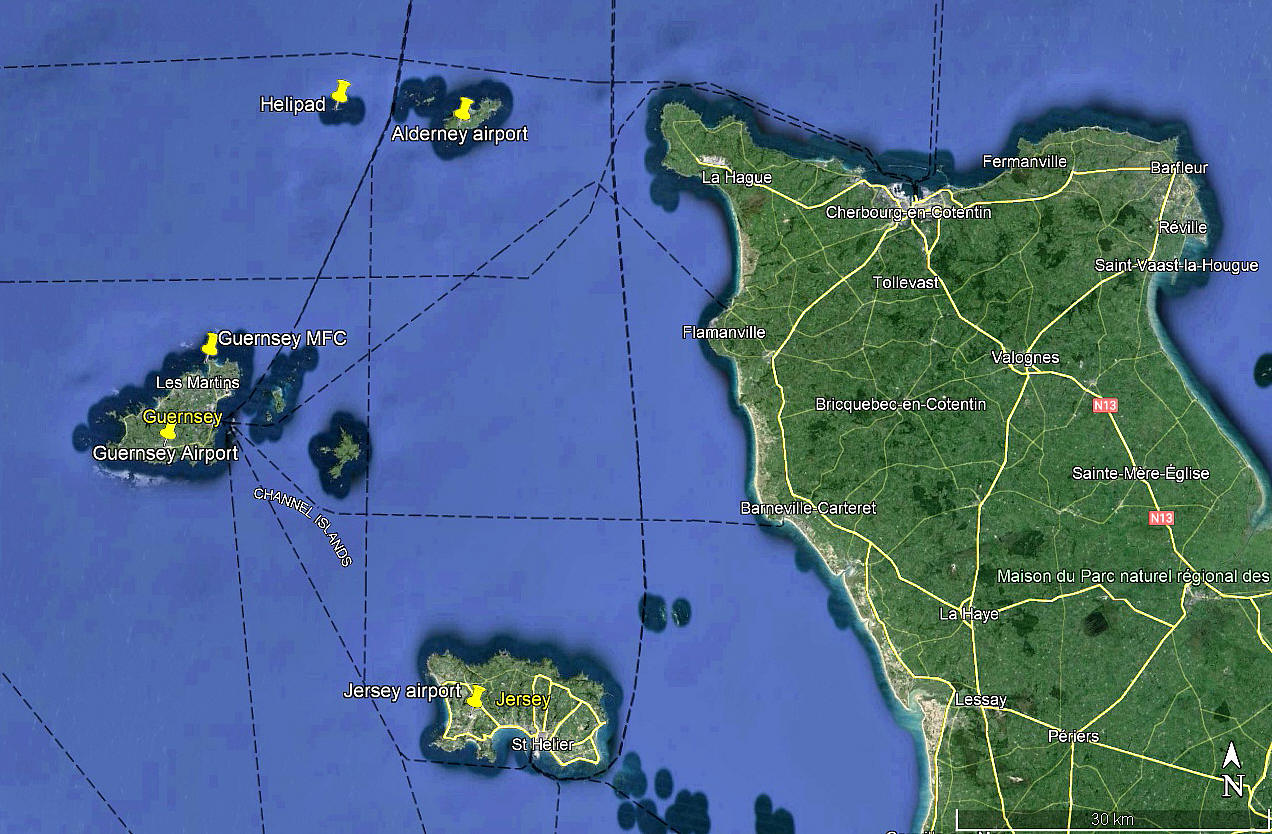Alderney Airport
ALDERNEY: Civil regional airport
ICAO code: EGJA IATA code: ACI
Third picture: This picture, c/o www.visitalderney.com ,was scanned from the May 2018 edition of Light Aviation magazine.
Operated by: 2001: States of Guernsey (States of Guernsey Airport, Guernsey Channel Islands)
British airline users: Post 1945: Alderney Air Ferries, Aurigny Air Services, *Blue Line Airways?, British European Airways, British Islands Airlines, Brymon Aviation, Jersey Airlines
Note: In 1974 it appears that only Aurigny Air Services were operating here with Brittan-Norman Islanders and Trislanders, with services to Cherbourg, Guernsey, Jersey and Southampton.
Second Note: In early 2018 it was mooted that a new airline, Air Alderney, operating two Islanders, would be operating services to JERSEY, LEE-on-SOLENT and SHOREHAM. Did it succeed?
A MIKE CHARLTON GALLERY
Notes: These pictures from postcards were kindly sent by Mike Charlton who has an amazing collection. See, www.aviationpostcards.co.uk
First picture: Unless I am badly mistaken, I think this picture shows a BEA (British European Airways) de Havilland DH89A Dragon Rapide. Presumably in the 1950s? However, I don't think the other Dragon Rapide, just glimpsed on the right of the picture was a BEA example. Can anybody kindly offer advice?
Third and fourth pictures. If anybody can kindly provide dates for when these pictures were taken, this advice will be most welcome. Regarding the fourth picture, Aurigny based on Guernsey were for many years the main UK operater of the Britton-Norman BN-2A Mk.III-2 Trislander, which performed sterlng service.
Charter, air taxi: Post 1945: Alderney Air Charter, Alderney Flying Sevices
Note: In 1974 it appears that Alderney Flying Services were operating the Wassmer WA41 Baladou G-BAGM.
Flying school: Alderney Flying Club
Location: 1nm SW of St Annes
Period of operation: 1938 (apart from WW2 – perhaps used by the Luftwaffe?) to present day
Runways: 1939: E/W 521 grass N/S 334 grass
NE/SW 302 grass SE/NW 549 grass
Were the N/S and NE/SW runways used for landings only, unless a stiff wind was blowing? By todays standards a runway well short of 400 metres would be generally regarded as a microlight strip and even 549 metres marginal for GA use. Prior to WW2 most private aircraft and regional airliners were designed with ‘high-lift’ wings able to land and take-off in very short distances. Indeed, the comparative rule same applied to large airliners and military types. The major disadvantage of a high-lift wing being the massive induced drag, which means the aircraft couldn’t go very fast. When slats and flaps were invented the picture changed completely and anybody sitting near the wing on a modern airliner on the approach to land might well be forgiven for asking, “Where the hell did the wing go?”
Note: These maps are reproduced with the kind permission of Pooleys Flight Equipment Ltd. Copyright Robert Pooley 2014.
1965: 09/27 880x36 grass 04/22 496x36 grass 14/32 880x36 grass
1990 to 2000: 08/26 880x23 hard/grass 03/21 497x37 grass 14/32 732x37 grass
A MICHAEL T HOLDER GALLERY
We have Mike Holder, a great friend of this 'Guide', to thank for providing the following items.
The Notice was published in Flight magazine on the 11th July 1935.
SOME VALUABLE HISTORY
The following four items are excerpts from The Aviation Historian in volumes No.23 and No.25.
Note: These pictures were also obtained from The Aviation Historian.
Picture One, the Windhover in the hangar at the Saro works in Cowes. Picture Two, the Windhover on the water - but where? My guess is St Peters Port, Guernsey. Three BEA DH.89A Dragon Rapides at Jersey.
G-AGSH also from The Aviation Historian. (When operated by BEA, British European Airways)
The de Havilland DH.89A Dragon Rapide first flew on the 17th April 1934 and soon established itself as being the favourite short haul airliner amongst UK airlines. After WW2 it most certainly itself as the dominant type in this short haul/feederliner role. G-AGSH however, was built in the Brush Coachworks, Loughborough in 1945, as a Dominie, (for the RAF I think?), as NR808. Soon converted for civil operations the first user was Channel Islands Airways (Jersey) from 25.07.45 until 22.11.46.
The Ministry of Civil Aviation acquired her from 28.11.46 until 01.01.47. She then went to British European Airways serving from 01.05.47 until 04.05.56, no doubt spending much of her time in the Channel Islands, and indeed, the next operator was Airlines (Jersey) Ltd - 12.02.59 until 03.08.61. Her connection with Channel Islands continued later on, and it appears, was still flying in 2024.
SOME MODERN PICTURES OBTAINED FROM GOOGLE
The apron scene shows the Dornier 228-212 G-OAUR. This was registered to Aurigny on 19.10.2016. The area view is from my Google Earth derived database.
NOTES: *I am not at all certain the Blue Line Airways flew to Alderney – they certainly flew Avro Ansons to “the Channel Islands” (presumably GUERNSEY and JERSEY?) from TOLLERTON (NOTTINGHAMSHIRE). The Anson was actually a very capable short-field machine and even heavily laden Anson could lift-off in about 320 metres so at least two of the original grass runways could be used for take-off and all four runways used for landing.
The caption for the leading photograph makes for interesting reading: "The BEA Airport Alderney is 292 ft above sea level. Here is the BEA bus and the aircraft which plies between Southampton and Guernsey and Alderney." The aircraft is of course a de Havilland DH89A Dragon Rapide, a type which BEA also used from Lands End to the Scilly Isles and extensively in Scotland after WW2 and into the 1950s. What I also find intriguing is that Jersey isn't mentioned as a BEA destination, at this time!
This seems to date this picture to the late 1940s? Being independent of the UK, Jersey was being served by its own home based airline, (or airlines), so perhaps BEA was finding it problematic to obtain permission to operate? Jersey would have been almost certainly (?) served by BEA DC-3s from Northolt (LONDON). However, if correct it does seem odd that their Dragon Rapides would not have provided a feeder link between the three main Channel Islands. At least initially after WW2.
In 1990 runway 08/26 had a ‘Bitmac’ strip 18 metres wide, still the case in 2000
ALDERNEY ‘Airport’ does appear to be the first purpose built ‘Airport’ in the Channel Islands. Regarding Jersey for example, before WW2 the visiting airlines landed on the beach near to St Helier. See: St AUBINS BAY. Jersey airport was opened in 1937.
We'd love to hear from you, so please scroll down to leave a comment!
Leave a comment ...
Copyright (c) UK Airfield Guide











































